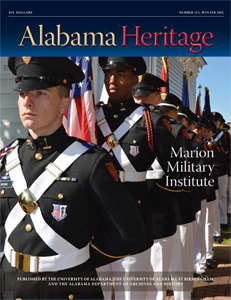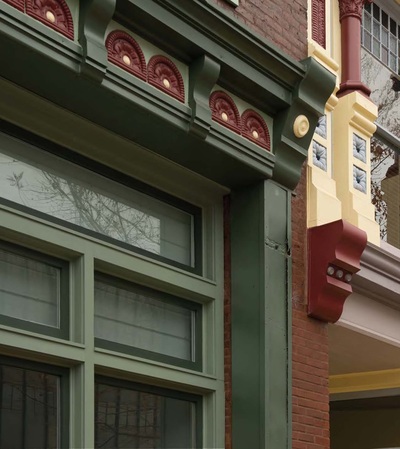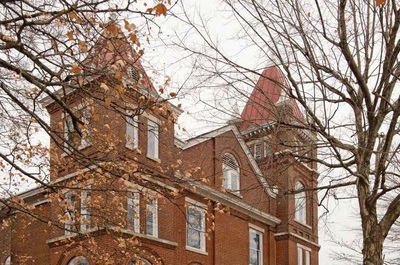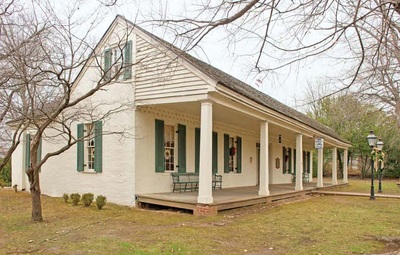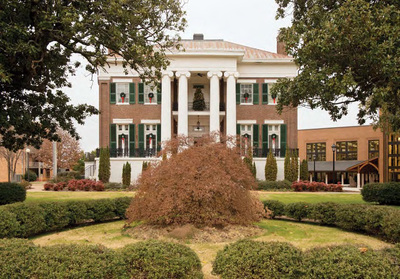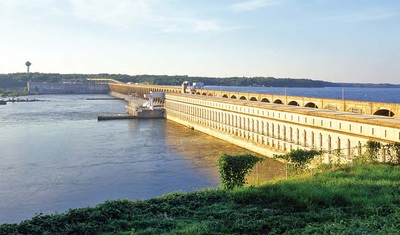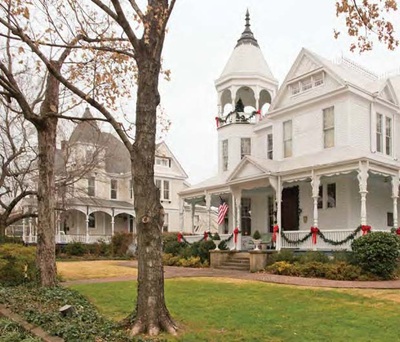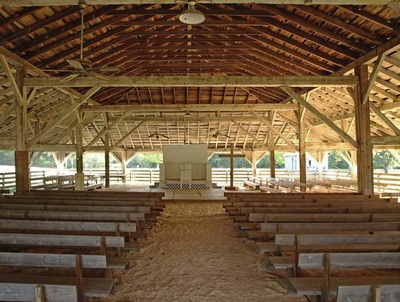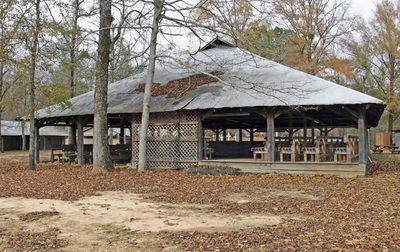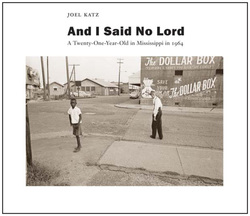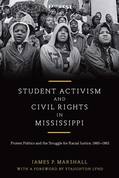|
On the cover: The Marion Military Institute Color Guard at the 2013 Alabama Military Hall of Honor Induction ceremony. (Marion Military Institute Foundation)
|
FEATURE ABSTRACTS
Florence: Discovering Alabama's Renaissance City
By Carolyn M. Barske
In 1818 the Cypress Land Company held the first auction for land in a new town on the banks of the Tennessee River in northwest Alabama. Since then, Florence has grown into a thriving community with strong educational, agricultural, and industrial roots.
As it approaches its two-hundredth anniversary, the community of Florence has lots to celebrate. Founded by a conglomerate that included Andrew Jackson and situated near the Tennessee River at a crossroads of nineteenth-century trade and expansion, through the centuries Florence has retained its historical charm and character, even as it advances into the twenty-first century. Throughout its history, Florence has adapted to circumstances and conditions, developing new educational institutions, arts centers, and important industrial facilities even as it maintains its small-town charm. Carolyn Barske explores the many characteristics that have helped Florence earned the nickname of Alabama’s Renaissance city—a tribute to the community and a reminder of the Italian city for which it was named.
About the Author
Carolyn M. Barske is an assistant professor of history and the director of the University of North Alabama (UNA) Public History Center. A native New Englander, Barske first came south to attend college at Sewanee: The University of the South. She then returned to the North to attend Northeastern University for her MA and the University of Massachusetts, Amherst, for her PhD. Since returning to the South, Barske taught at the University of Alabama, Huntsville, and Middle Tennessee State University. An accomplished equestrian, Barske also served as the associate director of the Sewanee Equestrian Center from 2008–2011. Upon moving to Florence, Barske became very involved with the local history community. In 2014 she and three graduate students in the public history program at UNA published Images of America: Florence. She sits on the boards of the Tennessee Valley Historical Society, the Natchez Trace Parkway Association, and the Muscle Shoals National Heritage Area, and also serves on the National Register Review Board for the State of Alabama.
By Carolyn M. Barske
In 1818 the Cypress Land Company held the first auction for land in a new town on the banks of the Tennessee River in northwest Alabama. Since then, Florence has grown into a thriving community with strong educational, agricultural, and industrial roots.
As it approaches its two-hundredth anniversary, the community of Florence has lots to celebrate. Founded by a conglomerate that included Andrew Jackson and situated near the Tennessee River at a crossroads of nineteenth-century trade and expansion, through the centuries Florence has retained its historical charm and character, even as it advances into the twenty-first century. Throughout its history, Florence has adapted to circumstances and conditions, developing new educational institutions, arts centers, and important industrial facilities even as it maintains its small-town charm. Carolyn Barske explores the many characteristics that have helped Florence earned the nickname of Alabama’s Renaissance city—a tribute to the community and a reminder of the Italian city for which it was named.
About the Author
Carolyn M. Barske is an assistant professor of history and the director of the University of North Alabama (UNA) Public History Center. A native New Englander, Barske first came south to attend college at Sewanee: The University of the South. She then returned to the North to attend Northeastern University for her MA and the University of Massachusetts, Amherst, for her PhD. Since returning to the South, Barske taught at the University of Alabama, Huntsville, and Middle Tennessee State University. An accomplished equestrian, Barske also served as the associate director of the Sewanee Equestrian Center from 2008–2011. Upon moving to Florence, Barske became very involved with the local history community. In 2014 she and three graduate students in the public history program at UNA published Images of America: Florence. She sits on the boards of the Tennessee Valley Historical Society, the Natchez Trace Parkway Association, and the Muscle Shoals National Heritage Area, and also serves on the National Register Review Board for the State of Alabama.
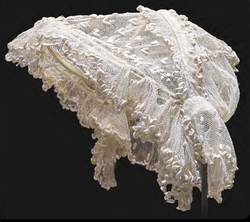 Sarah Gayle’s diary is a unique account of life in early Alabama. (The W. S. Hoole Special Collections Library, The University of Alabama)
Sarah Gayle’s diary is a unique account of life in early Alabama. (The W. S. Hoole Special Collections Library, The University of Alabama)
Sarah Gayle and Violence in the Old Southwest
By Sarah Woolfolk Wiggins
When Sarah Haynsworth’s family settled on the Alabama frontier, it was quite an unruly place, still a territory and marked by wars between settlers and the Native Americans they displaced, and ruled largely by the violence and wildness of the American southwest. Her marriage to John Gayle allowed Sarah to experience life at the center of Alabama’s early statehood. Thanks to her diaries—many composed in Sarah’s long stretches of isolation while John, one of Alabama’s early governors, traveled—we have a lively and poignant understanding of life in this violent and often lonely time. Sarah’s journals offer a rare and sensitive glimpse of the opportunities and challenges faced by the state of Alabama’s first women settlers.
By Sarah Woolfolk Wiggins
When Sarah Haynsworth’s family settled on the Alabama frontier, it was quite an unruly place, still a territory and marked by wars between settlers and the Native Americans they displaced, and ruled largely by the violence and wildness of the American southwest. Her marriage to John Gayle allowed Sarah to experience life at the center of Alabama’s early statehood. Thanks to her diaries—many composed in Sarah’s long stretches of isolation while John, one of Alabama’s early governors, traveled—we have a lively and poignant understanding of life in this violent and often lonely time. Sarah’s journals offer a rare and sensitive glimpse of the opportunities and challenges faced by the state of Alabama’s first women settlers.
About the Author
Sarah Woolfolk Wiggins is professor emerita of history at the University of Alabama, a past president of the Alabama Historical Association, and editor of the Alabama Review for twenty years. She is the author or editor of The Scalawag in Alabama Politics, 1865–1881 (University of Alabama Press, 1977); From Civil War to Civil Rights—Alabama 1860–1960 (University of Alabama Press, 1987); The Journals of Josiah Gorgas, 1857–1878 (University of Alabama Press, 1995); Love and Duty: Amelia and Josiah Gorgas and Their Family (University of Alabama Press, 2005); and The Journal of Sarah Haynsworth Gayle, 1827–1835 (University of Alabama Press, 2013).
Sarah Woolfolk Wiggins is professor emerita of history at the University of Alabama, a past president of the Alabama Historical Association, and editor of the Alabama Review for twenty years. She is the author or editor of The Scalawag in Alabama Politics, 1865–1881 (University of Alabama Press, 1977); From Civil War to Civil Rights—Alabama 1860–1960 (University of Alabama Press, 1987); The Journals of Josiah Gorgas, 1857–1878 (University of Alabama Press, 1995); Love and Duty: Amelia and Josiah Gorgas and Their Family (University of Alabama Press, 2005); and The Journal of Sarah Haynsworth Gayle, 1827–1835 (University of Alabama Press, 2013).
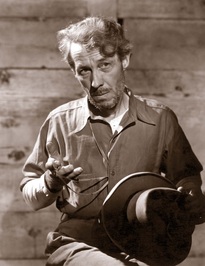 His early experience on the stage allowed Henry B. Walthall to make the transition to talkies, though often in small roles such as the zoo groundskeeper in the 1932 film "Central Park" starring Joan Blondell and Wallace Ford. (First National Pictures)
His early experience on the stage allowed Henry B. Walthall to make the transition to talkies, though often in small roles such as the zoo groundskeeper in the 1932 film "Central Park" starring Joan Blondell and Wallace Ford. (First National Pictures)
Alabama's Own Henry B. Walthall
By Joanna Jacobs
For a brief moment toward the beginning of the motion picture industry, one of the biggest stars in the world was a slight, refined, serious-looking farmer’s son from central Alabama.
Although little-known today, Henry B. Walthall once graced screens and captivated audiences nationwide, starring in numerous films, playing a wide range of roles, and successfully transitioning from the silent film era into the “talkies.” An Alabama native, Walthall often played southern men, from gentlemen to scoundrels, kind souls to the founder of the KKK. Walthall adopted a private persona, but his life held plenty of its own drama, making him as fascinating a character as the people he played on the big screen.
Additional Information
Watch Henry Walthall star with Lillian Gish, Mae Marsh, and Miriam Cooper in "The Birth of a Nation" (1915), directed by D. W. Griffith: https://www.youtube.com/watch?v=302YMeiDSrI
About the Author
Joanna Jacobs is the assistant managing editor at the University of Alabama Press. As a freelance writer, her articles and reviews have appeared in Alabama Heritage, Coastal Living, Southern Accents, and The Tuscaloosa News. She has taught about film for the Osher Lifelong Learning Institute. For assistance on this article, she thanks Anthony Buhr, Jeremy Butler, Curtis Clark, Stephanie Jacobs, Crissie E. Johnson, Vanessa L. Rusch, Ed Sikov, Anna J. Singer, Edward Tang, and Jennifer Taylor, Rachel Cohen, Greg Laughlin, and Edward Craig at the Samford University Libraries, and she offers special thanks to Diana Cueto Dall’Occhio.
By Joanna Jacobs
For a brief moment toward the beginning of the motion picture industry, one of the biggest stars in the world was a slight, refined, serious-looking farmer’s son from central Alabama.
Although little-known today, Henry B. Walthall once graced screens and captivated audiences nationwide, starring in numerous films, playing a wide range of roles, and successfully transitioning from the silent film era into the “talkies.” An Alabama native, Walthall often played southern men, from gentlemen to scoundrels, kind souls to the founder of the KKK. Walthall adopted a private persona, but his life held plenty of its own drama, making him as fascinating a character as the people he played on the big screen.
Additional Information
Watch Henry Walthall star with Lillian Gish, Mae Marsh, and Miriam Cooper in "The Birth of a Nation" (1915), directed by D. W. Griffith: https://www.youtube.com/watch?v=302YMeiDSrI
About the Author
Joanna Jacobs is the assistant managing editor at the University of Alabama Press. As a freelance writer, her articles and reviews have appeared in Alabama Heritage, Coastal Living, Southern Accents, and The Tuscaloosa News. She has taught about film for the Osher Lifelong Learning Institute. For assistance on this article, she thanks Anthony Buhr, Jeremy Butler, Curtis Clark, Stephanie Jacobs, Crissie E. Johnson, Vanessa L. Rusch, Ed Sikov, Anna J. Singer, Edward Tang, and Jennifer Taylor, Rachel Cohen, Greg Laughlin, and Edward Craig at the Samford University Libraries, and she offers special thanks to Diana Cueto Dall’Occhio.
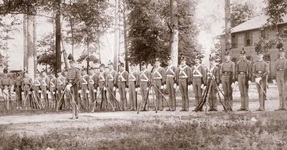 Howard College in Marion had followed a military mode of education. (Marion Military Institute Foundation)
Howard College in Marion had followed a military mode of education. (Marion Military Institute Foundation)
Marion Military Institute: The Military College of Alabama
By Joseph W. ("Bill") Mathews Jr.
Near the end of the nineteenth century, Howard College experienced a large change—its relocation from Marion to Birmingham, where it eventually became Samford University. The campus left behind in Marion benefitted from the presence of J.T. Murfee, who had been Howard College’s president and who stayed in the community, founding the Marion Institute. Thanks to Murfee and his descendants, the Marion Institute helped establish a tradition of military education that continues to thrive today.
By Joseph W. ("Bill") Mathews Jr.
Near the end of the nineteenth century, Howard College experienced a large change—its relocation from Marion to Birmingham, where it eventually became Samford University. The campus left behind in Marion benefitted from the presence of J.T. Murfee, who had been Howard College’s president and who stayed in the community, founding the Marion Institute. Thanks to Murfee and his descendants, the Marion Institute helped establish a tradition of military education that continues to thrive today.
About the Author
Bill Mathews attended high school and junior college at Marion Military Institute (MMI), where he obtained the rank of cadet colonel and completed senior ROTC. Upon completion of his BA degree from Birmingham-Southern College, he was commissioned a second lieutenant in the US Army. After practicing law in a private law firm for thirty years, he served as vice president for business affairs and general counsel at Samford University. After retiring from Samford, he served as vice president and general counsel for Judson College. He is a member of Siloam Baptist Church in Marion and has served on MMI’s president’s advisory council for many years. A member of the Perry County Historical and Preservation Society, his hobby since his first year at MMI has been the history of Howard College, MMI, Judson College, Siloam Baptist Church, Marion, and Perry County.
Bill Mathews attended high school and junior college at Marion Military Institute (MMI), where he obtained the rank of cadet colonel and completed senior ROTC. Upon completion of his BA degree from Birmingham-Southern College, he was commissioned a second lieutenant in the US Army. After practicing law in a private law firm for thirty years, he served as vice president for business affairs and general counsel at Samford University. After retiring from Samford, he served as vice president and general counsel for Judson College. He is a member of Siloam Baptist Church in Marion and has served on MMI’s president’s advisory council for many years. A member of the Perry County Historical and Preservation Society, his hobby since his first year at MMI has been the history of Howard College, MMI, Judson College, Siloam Baptist Church, Marion, and Perry County.
DEPARTMENT ABSTRACTS
Southern Architecture & Preservation
The Tabernacle: Centerpiece of Alabama’s Early Camp Meetings
By Michael W. Panhorst
Michael Panhorst is admittedly “hooked” on vernacular religious architecture. Here he introduces Alabama Heritage readers to the architecture of old-time camp meetings. An outgrowth of the evangelical revival that swept post–Revolutionary America, the campground and its tabernacles were at one time distinctive features of the rural Alabama landscape. Very few of these once-common structures survive, but Panhorst explains their significance to some of Alabama’s religious communities.
About the Author
Michael W. Panhorst, PhD, is a historian of art and architecture and an advocate for historic preservation. His book, The Memorial Art and Architecture of Vicksburg National Military Park, has just been published by Kent State University Press. Robert Gamble, standing editor of the “Southern Architecture and Preservation” department of Alabama Heritage, recently retired as senior architectural historian for the Alabama Historical Commission.
The Tabernacle: Centerpiece of Alabama’s Early Camp Meetings
By Michael W. Panhorst
Michael Panhorst is admittedly “hooked” on vernacular religious architecture. Here he introduces Alabama Heritage readers to the architecture of old-time camp meetings. An outgrowth of the evangelical revival that swept post–Revolutionary America, the campground and its tabernacles were at one time distinctive features of the rural Alabama landscape. Very few of these once-common structures survive, but Panhorst explains their significance to some of Alabama’s religious communities.
About the Author
Michael W. Panhorst, PhD, is a historian of art and architecture and an advocate for historic preservation. His book, The Memorial Art and Architecture of Vicksburg National Military Park, has just been published by Kent State University Press. Robert Gamble, standing editor of the “Southern Architecture and Preservation” department of Alabama Heritage, recently retired as senior architectural historian for the Alabama Historical Commission.
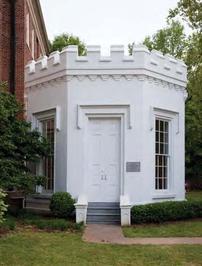 The Round House, built as a guard house in 1859, was one of only four buildings to survive the Union raid at the University of Alabama. (Library of Congress)
The Round House, built as a guard house in 1859, was one of only four buildings to survive the Union raid at the University of Alabama. (Library of Congress)
Becoming Alabama
By Joseph Pearson, Megan L. Bever, and Matthew L. Downs
Editor’s Note--Alabama Heritage, the Summersell Center for Study of the South, the University of Alabama Department of History, and the Alabama Tourism Department offer this department as a part of the statewide “Becoming Alabama” initiative—a cooperative venture of state organizations to commemorate Alabama’s experiences related to the Creek War, the Civil War, and the civil rights movement. Quarter by quarter we will take you to the corresponding seasons 200, 150, and 50 years ago—sometimes describing pivotal events, sometimes describing daily life, but always illuminating a world in flux. We will wait for the ultimate outcomes as our forebears did—over time. For those joining the story in progress, you can find earlier quarters on our website at www.alabamaheritage.com/becoming-alabama.
In this quarter’s installment of “Becoming Alabama,” Joseph Pearson explores the effect of the Battle of New Orleans on the tensions between Creeks and settlers. Megan Bever illuminates the havoc wreaked by John Croxton and his men, known as Croxton’s Raiders, as they swept through Tuscaloosa, destroying much of the town and the University of Alabama campus. Finally, Matthew Downs details the assassination of civil rights leader Malcolm X. In each component of this department, authors demonstrate how significant moments in Alabama’s past also reflected the larger issues at work in our nation.
About the Authors
Joseph W. Pearson is an assistant professor of history at Union College. His dissertation, completed at the University of Alabama, explores the political culture of the American Whigs, specifically probing the shared underpinnings of their political thought and moral temper across class, gender, and section. Megan L. Bever is an assistant professor of history at Missouri Southern State University. Her dissertation, completed at the University of Alabama, explores alcohol, morality, and citizenship in the Civil War era. Matthew L. Downs (PhD, Alabama) is an assistant professor of history at the University of Mobile. His dissertation focused on the federal government’s role in the economic development of the Tennessee Valley.
By Joseph Pearson, Megan L. Bever, and Matthew L. Downs
Editor’s Note--Alabama Heritage, the Summersell Center for Study of the South, the University of Alabama Department of History, and the Alabama Tourism Department offer this department as a part of the statewide “Becoming Alabama” initiative—a cooperative venture of state organizations to commemorate Alabama’s experiences related to the Creek War, the Civil War, and the civil rights movement. Quarter by quarter we will take you to the corresponding seasons 200, 150, and 50 years ago—sometimes describing pivotal events, sometimes describing daily life, but always illuminating a world in flux. We will wait for the ultimate outcomes as our forebears did—over time. For those joining the story in progress, you can find earlier quarters on our website at www.alabamaheritage.com/becoming-alabama.
In this quarter’s installment of “Becoming Alabama,” Joseph Pearson explores the effect of the Battle of New Orleans on the tensions between Creeks and settlers. Megan Bever illuminates the havoc wreaked by John Croxton and his men, known as Croxton’s Raiders, as they swept through Tuscaloosa, destroying much of the town and the University of Alabama campus. Finally, Matthew Downs details the assassination of civil rights leader Malcolm X. In each component of this department, authors demonstrate how significant moments in Alabama’s past also reflected the larger issues at work in our nation.
About the Authors
Joseph W. Pearson is an assistant professor of history at Union College. His dissertation, completed at the University of Alabama, explores the political culture of the American Whigs, specifically probing the shared underpinnings of their political thought and moral temper across class, gender, and section. Megan L. Bever is an assistant professor of history at Missouri Southern State University. Her dissertation, completed at the University of Alabama, explores alcohol, morality, and citizenship in the Civil War era. Matthew L. Downs (PhD, Alabama) is an assistant professor of history at the University of Mobile. His dissertation focused on the federal government’s role in the economic development of the Tennessee Valley.
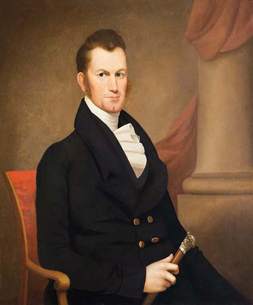 William Wyatt Bibb followed his younger brother Thomas (shown) to Alabama, becoming the governor of the Alabama Territory and then the first governor of the new state. When William died in office as the result of a riding accident, Thomas, as president of the senate, succeeded his brother and completed his term. (Alabama Department of Archives and History)
William Wyatt Bibb followed his younger brother Thomas (shown) to Alabama, becoming the governor of the Alabama Territory and then the first governor of the new state. When William died in office as the result of a riding accident, Thomas, as president of the senate, succeeded his brother and completed his term. (Alabama Department of Archives and History)
Alabama Governors
William Wyatt Bibb (1819-1820) and Thomas Bibb (1820-1821)
By Samuel L. Webb
William Wyatt Bibb, one of Alabama’s early settlers, was named its territorial governor in 1817. Although he held a somewhat contentious position, he won the race to become Alabama’s first state governor. Upon William’s death, his brother Thomas, president of the Alabama state senate, assumed the governorship. Samuel L. Webb reflects on the Bibb family legacy in this installment of the “Alabama Governors” column.
About the Author
Samuel L. Webb, a native of York, Alabama, holds a JD from the University of Alabama School of Law and a PhD in history from the University of Arkansas. He taught history at the University of Alabama at Birmingham from 1988 to 2009 and is now an adjunct professor at the University of Alabama.
William Wyatt Bibb (1819-1820) and Thomas Bibb (1820-1821)
By Samuel L. Webb
William Wyatt Bibb, one of Alabama’s early settlers, was named its territorial governor in 1817. Although he held a somewhat contentious position, he won the race to become Alabama’s first state governor. Upon William’s death, his brother Thomas, president of the Alabama state senate, assumed the governorship. Samuel L. Webb reflects on the Bibb family legacy in this installment of the “Alabama Governors” column.
About the Author
Samuel L. Webb, a native of York, Alabama, holds a JD from the University of Alabama School of Law and a PhD in history from the University of Arkansas. He taught history at the University of Alabama at Birmingham from 1988 to 2009 and is now an adjunct professor at the University of Alabama.
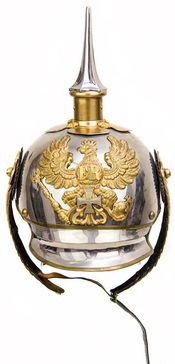 Many wartime souvenirs traveled to the US with returning servicemen, but few were as uncommon as this Prussian Cuirassier (cavalry) Reserve Officer’s helmet. These ornate styles were replaced with the more protective Stahlhelm. (Alabama Department of Archives and History)
Many wartime souvenirs traveled to the US with returning servicemen, but few were as uncommon as this Prussian Cuirassier (cavalry) Reserve Officer’s helmet. These ornate styles were replaced with the more protective Stahlhelm. (Alabama Department of Archives and History)
From the Archives
Alabamians in the Great War
By Graham Neeley and Georgia Ann Conner
Editor’s Note: This issue of Alabama Heritage inaugurates a new department on the collections of the Alabama Department of Archives and History. Curator Graham Neeley sheds light on the process by which the archives came to acquire a particularly strong collection of World War I artifacts and records, many of which are currently on display in a new exhibit, “Alabamians in the Great War,” in the archives’ Museum of Alabama.
The new archival exhibit commemorates the notable contributions of Alabama servicemen in World War One. Many artifacts including some extremely rare items, were collected, thanks largely to members of the 167th Infantry Regiment, led by Alabama’s own Col. Bill Screws.
About the Authors
Graham Neeley is a curator at the Alabama Department of Archives and History. Neeley holds a BA in history from Huntingdon College. Georgia Ann Conner is the communications officer at the Alabama Department of Archives and History and is a native of Baldwin County, Alabama. She is a graduate of Furman University and holds a BA in history and a BA in studio art. Sponsorship for this department is provided by Lee Sentell and the Alabama Tourism Department.
Additional Information
For information about the Museum of Alabama and its many exhibits, including “Alabamians in the Great War,” please visit http://www.museum.alabama.gov/.
For more information about the role of Alabamians in WWI, please consult Nimrod T. Frazer’s book Send the Alabamians: World War I Fighters in the Rainbow (University of Alabama Press, 2014).
Alabamians in the Great War
By Graham Neeley and Georgia Ann Conner
Editor’s Note: This issue of Alabama Heritage inaugurates a new department on the collections of the Alabama Department of Archives and History. Curator Graham Neeley sheds light on the process by which the archives came to acquire a particularly strong collection of World War I artifacts and records, many of which are currently on display in a new exhibit, “Alabamians in the Great War,” in the archives’ Museum of Alabama.
The new archival exhibit commemorates the notable contributions of Alabama servicemen in World War One. Many artifacts including some extremely rare items, were collected, thanks largely to members of the 167th Infantry Regiment, led by Alabama’s own Col. Bill Screws.
About the Authors
Graham Neeley is a curator at the Alabama Department of Archives and History. Neeley holds a BA in history from Huntingdon College. Georgia Ann Conner is the communications officer at the Alabama Department of Archives and History and is a native of Baldwin County, Alabama. She is a graduate of Furman University and holds a BA in history and a BA in studio art. Sponsorship for this department is provided by Lee Sentell and the Alabama Tourism Department.
Additional Information
For information about the Museum of Alabama and its many exhibits, including “Alabamians in the Great War,” please visit http://www.museum.alabama.gov/.
For more information about the role of Alabamians in WWI, please consult Nimrod T. Frazer’s book Send the Alabamians: World War I Fighters in the Rainbow (University of Alabama Press, 2014).
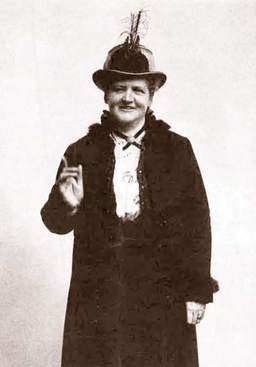 Ida Mathis used her knowledge of agriculture and the force of her personality to educate Alabama’s poor farmers on the dangers of over-reliance on cotton farming. (The Outlook)
Ida Mathis used her knowledge of agriculture and the force of her personality to educate Alabama’s poor farmers on the dangers of over-reliance on cotton farming. (The Outlook)
Alabama Women
The Crusade of “Mrs. Moses”: Ida Mathis and the Cotton Crisis of 1914
By Rebecca Montgomery
A well-educated woman, Ida Brandon grew up in the Florence community, where she was prepared for a quiet domestic life. However, after marrying Giles Huffman Mathis and inheriting money of her own, Ida set out to do something radically different from what her upbringing had prepared her for: she decided to revolutionize the American agricultural system. Through her innovative ideas and careful teaching, she did just that.
About the Author
Rebecca Montgomery is associate professor and director of graduate studies in the history department at Texas State University. Joshua D. Rothman, standing editor of the “Alabama Women” department of Alabama Heritage, is professor of history at the University of Alabama and director of the university’s Frances S. Summersell Center for the Study of the South, which sponsors this department.
The Crusade of “Mrs. Moses”: Ida Mathis and the Cotton Crisis of 1914
By Rebecca Montgomery
A well-educated woman, Ida Brandon grew up in the Florence community, where she was prepared for a quiet domestic life. However, after marrying Giles Huffman Mathis and inheriting money of her own, Ida set out to do something radically different from what her upbringing had prepared her for: she decided to revolutionize the American agricultural system. Through her innovative ideas and careful teaching, she did just that.
About the Author
Rebecca Montgomery is associate professor and director of graduate studies in the history department at Texas State University. Joshua D. Rothman, standing editor of the “Alabama Women” department of Alabama Heritage, is professor of history at the University of Alabama and director of the university’s Frances S. Summersell Center for the Study of the South, which sponsors this department.
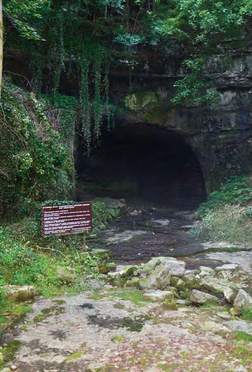 The gated entrance to the gray bat nursing facility, Sauta Cave, near Lake Guntersville, Jackson County, Alabama. (L. J. Davenport)
The gated entrance to the gray bat nursing facility, Sauta Cave, near Lake Guntersville, Jackson County, Alabama. (L. J. Davenport)
Nature Journal
Sundown at Sauta Cave
By L.J. Davenport
Larry Davenport describes a thrilling biological ritual: the period at sundown when nearly 250,000 grey bats leave the Sauta Cave in search of food. In the process, he reminds readers of the precarious place occupied by this endangered species and how fortunate Alabama is that they grace the state’s caves.
About the Author
Larry Davenport is a professor of biology at Samford University, Birmingham.
Additional Information
For additional information on Sauta Cave, please consult the following:
Encyclopedia of Alabama: www.encyclopediaofalabama.org/face/Multimedia.jsp?id=m-6867
US Fish & Wildlife Service: www.fws.gov/sautacave/
Sundown at Sauta Cave
By L.J. Davenport
Larry Davenport describes a thrilling biological ritual: the period at sundown when nearly 250,000 grey bats leave the Sauta Cave in search of food. In the process, he reminds readers of the precarious place occupied by this endangered species and how fortunate Alabama is that they grace the state’s caves.
About the Author
Larry Davenport is a professor of biology at Samford University, Birmingham.
Additional Information
For additional information on Sauta Cave, please consult the following:
Encyclopedia of Alabama: www.encyclopediaofalabama.org/face/Multimedia.jsp?id=m-6867
US Fish & Wildlife Service: www.fws.gov/sautacave/
Reading the Southern Past
Freedom Summer—1964
by Stephen Goldfarb
In this quarter’s “Reading the Southern Past,” Stephen Goldfarb tackles the historical period fifty years ago, when civil rights issues remained at the forefront of both the south and the nation. Under discussion are James P. Marshall’s Student Activism and Civil Rights in Mississippi: Protest Politics and the Struggle for Racial Justice, 1960–1965 (Louisiana State University Press, 2013); Charles E. Cobb Jr.’s This Nonviolent Stuff’ll Get You Killed: How Guns Made the Civil Rights Movement Possible (Basic Books, 2014); and Joel Katz’s And I Said No Lord: A Twenty-One-Year-Old in Mississippi in 1964 (University of Alabama Press, 2014).
About the Author
Stephen Goldfarb holds a PhD in the history of science and technology. He retired from a public library in 2003.
Freedom Summer—1964
by Stephen Goldfarb
In this quarter’s “Reading the Southern Past,” Stephen Goldfarb tackles the historical period fifty years ago, when civil rights issues remained at the forefront of both the south and the nation. Under discussion are James P. Marshall’s Student Activism and Civil Rights in Mississippi: Protest Politics and the Struggle for Racial Justice, 1960–1965 (Louisiana State University Press, 2013); Charles E. Cobb Jr.’s This Nonviolent Stuff’ll Get You Killed: How Guns Made the Civil Rights Movement Possible (Basic Books, 2014); and Joel Katz’s And I Said No Lord: A Twenty-One-Year-Old in Mississippi in 1964 (University of Alabama Press, 2014).
About the Author
Stephen Goldfarb holds a PhD in the history of science and technology. He retired from a public library in 2003.
